Financial Management and Decision Making: Calculation of Payback Period and Net Present Value
VerifiedAdded on 2023/06/07
|15
|1608
|399
AI Summary
This document covers the calculation of payback period and net present value for investment projects in financial management and decision making. It also includes a discussion on the relevance of break-even analysis and cost control process in large organizations. The document is relevant for students pursuing BSC (Hons) Business Management under Semester 1, Examination 2021/22, Module No: BMP5006.
Contribute Materials
Your contribution can guide someone’s learning journey. Share your
documents today.
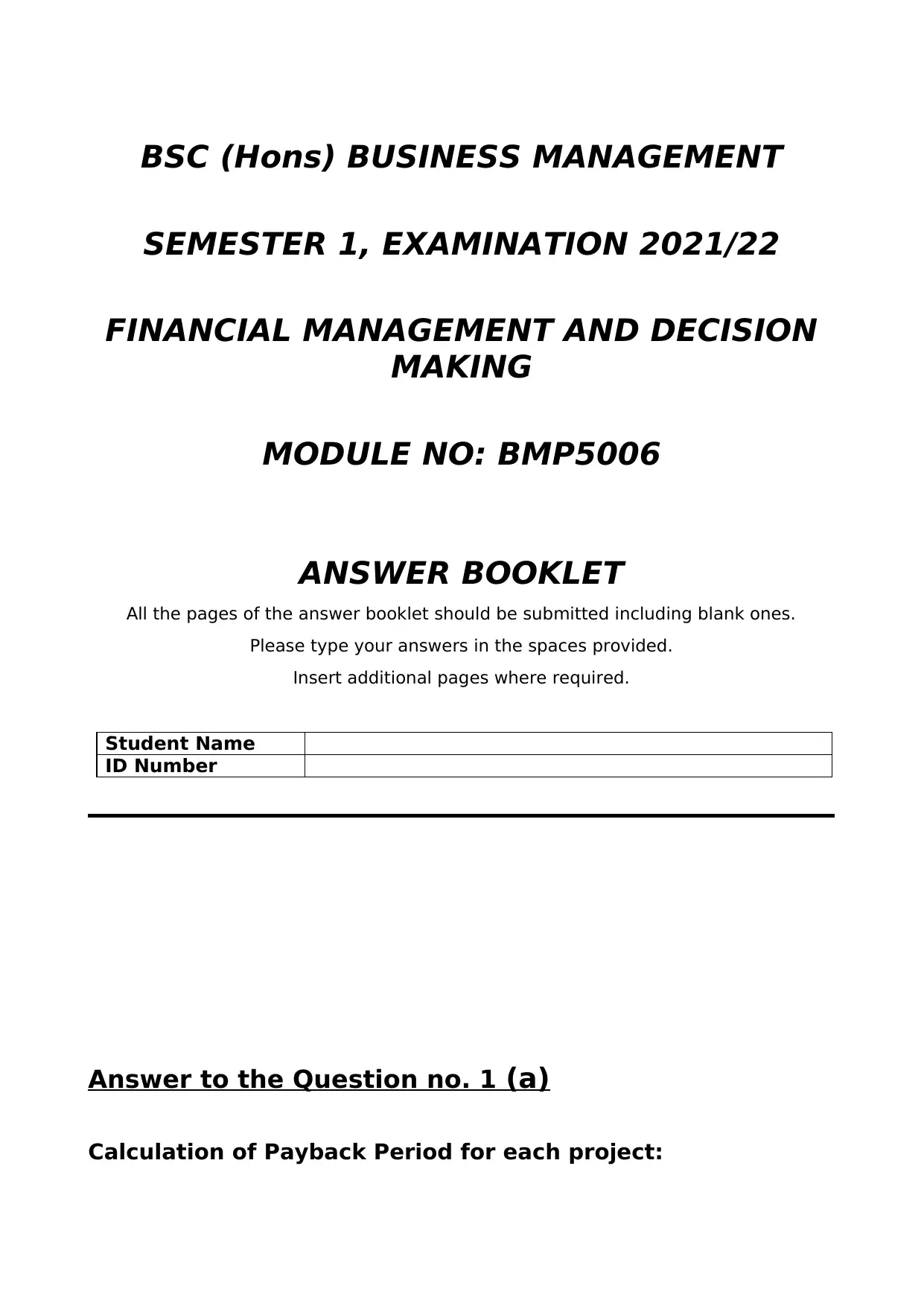
BSC (Hons) BUSINESS MANAGEMENT
SEMESTER 1, EXAMINATION 2021/22
FINANCIAL MANAGEMENT AND DECISION
MAKING
MODULE NO: BMP5006
ANSWER BOOKLET
All the pages of the answer booklet should be submitted including blank ones.
Please type your answers in the spaces provided.
Insert additional pages where required.
Student Name
ID Number
Answer to the Question no. 1 (a)
Calculation of Payback Period for each project:
SEMESTER 1, EXAMINATION 2021/22
FINANCIAL MANAGEMENT AND DECISION
MAKING
MODULE NO: BMP5006
ANSWER BOOKLET
All the pages of the answer booklet should be submitted including blank ones.
Please type your answers in the spaces provided.
Insert additional pages where required.
Student Name
ID Number
Answer to the Question no. 1 (a)
Calculation of Payback Period for each project:
Secure Best Marks with AI Grader
Need help grading? Try our AI Grader for instant feedback on your assignments.

C
U
M
U
L
A
T
I
V
E
C
A
S
H
F
L
O
W
S
2 of 15
U
M
U
L
A
T
I
V
E
C
A
S
H
F
L
O
W
S
2 of 15
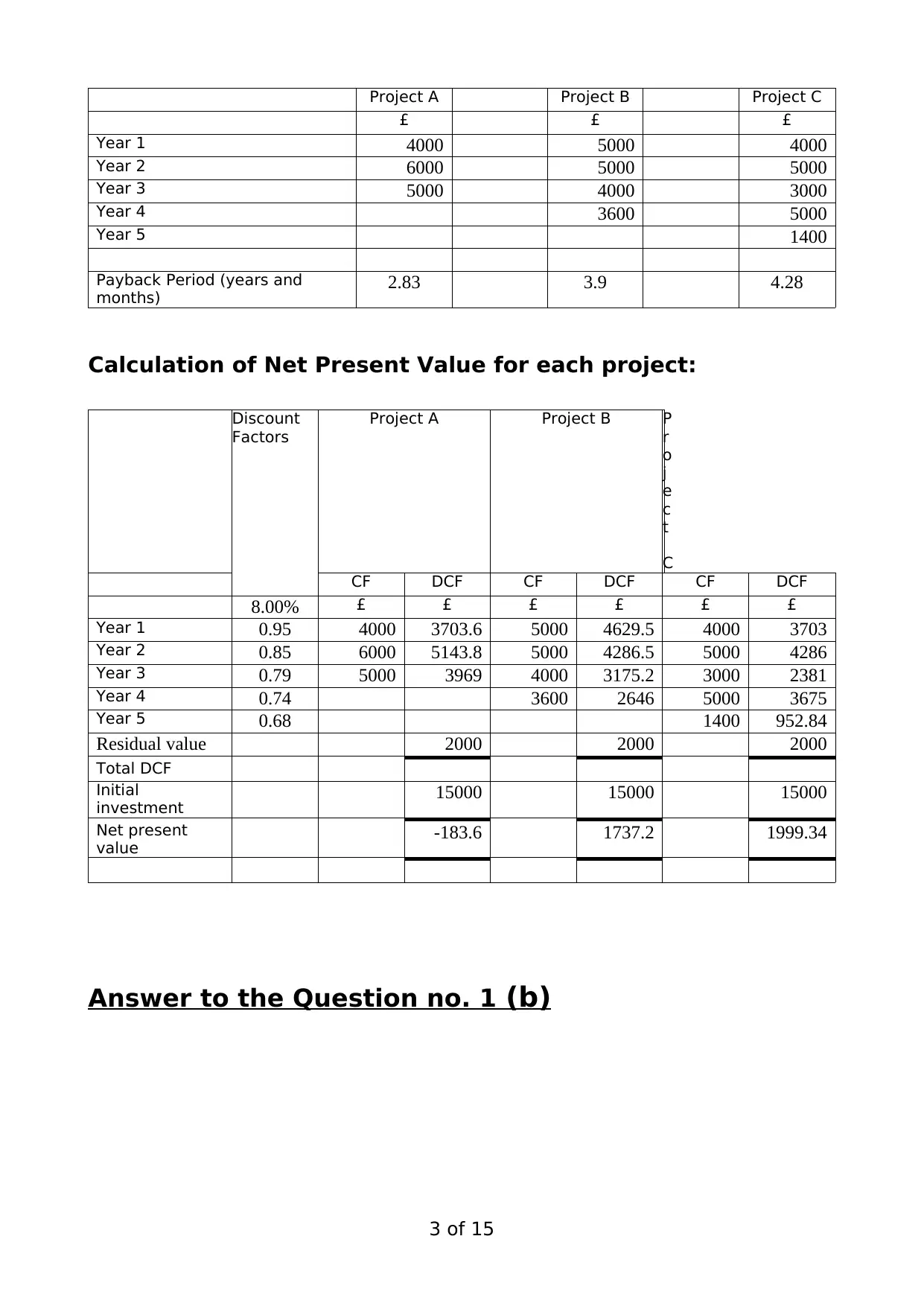
Project A Project B Project C
£ £ £
Year 1 4000 5000 4000
Year 2 6000 5000 5000
Year 3 5000 4000 3000
Year 4 3600 5000
Year 5 1400
Payback Period (years and
months) 2.83 3.9 4.28
Calculation of Net Present Value for each project:
Discount
Factors
Project A Project B P
r
o
j
e
c
t
C
CF DCF CF DCF CF DCF
8.00% £ £ £ £ £ £
Year 1 0.95 4000 3703.6 5000 4629.5 4000 3703
Year 2 0.85 6000 5143.8 5000 4286.5 5000 4286
Year 3 0.79 5000 3969 4000 3175.2 3000 2381
Year 4 0.74 3600 2646 5000 3675
Year 5 0.68 1400 952.84
Residual value 2000 2000 2000
Total DCF
Initial
investment 15000 15000 15000
Net present
value -183.6 1737.2 1999.34
Answer to the Question no. 1 (b)
3 of 15
£ £ £
Year 1 4000 5000 4000
Year 2 6000 5000 5000
Year 3 5000 4000 3000
Year 4 3600 5000
Year 5 1400
Payback Period (years and
months) 2.83 3.9 4.28
Calculation of Net Present Value for each project:
Discount
Factors
Project A Project B P
r
o
j
e
c
t
C
CF DCF CF DCF CF DCF
8.00% £ £ £ £ £ £
Year 1 0.95 4000 3703.6 5000 4629.5 4000 3703
Year 2 0.85 6000 5143.8 5000 4286.5 5000 4286
Year 3 0.79 5000 3969 4000 3175.2 3000 2381
Year 4 0.74 3600 2646 5000 3675
Year 5 0.68 1400 952.84
Residual value 2000 2000 2000
Total DCF
Initial
investment 15000 15000 15000
Net present
value -183.6 1737.2 1999.34
Answer to the Question no. 1 (b)
3 of 15
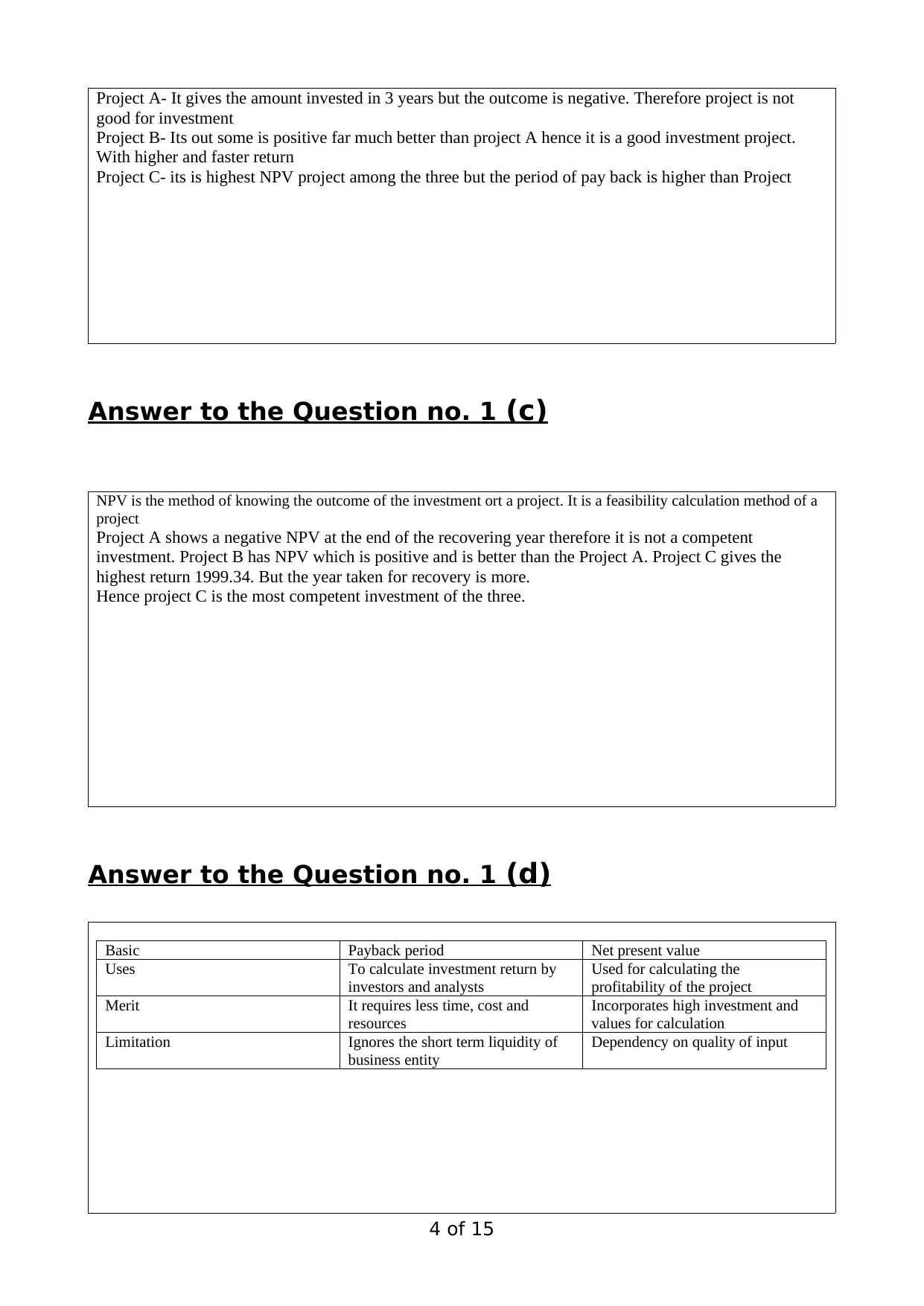
Project A- It gives the amount invested in 3 years but the outcome is negative. Therefore project is not
good for investment
Project B- Its out some is positive far much better than project A hence it is a good investment project.
With higher and faster return
Project C- its is highest NPV project among the three but the period of pay back is higher than Project
Answer to the Question no. 1 (c)
NPV is the method of knowing the outcome of the investment ort a project. It is a feasibility calculation method of a
project
Project A shows a negative NPV at the end of the recovering year therefore it is not a competent
investment. Project B has NPV which is positive and is better than the Project A. Project C gives the
highest return 1999.34. But the year taken for recovery is more.
Hence project C is the most competent investment of the three.
Answer to the Question no. 1 (d)
Basic Payback period Net present value
Uses To calculate investment return by
investors and analysts
Used for calculating the
profitability of the project
Merit It requires less time, cost and
resources
Incorporates high investment and
values for calculation
Limitation Ignores the short term liquidity of
business entity
Dependency on quality of input
4 of 15
good for investment
Project B- Its out some is positive far much better than project A hence it is a good investment project.
With higher and faster return
Project C- its is highest NPV project among the three but the period of pay back is higher than Project
Answer to the Question no. 1 (c)
NPV is the method of knowing the outcome of the investment ort a project. It is a feasibility calculation method of a
project
Project A shows a negative NPV at the end of the recovering year therefore it is not a competent
investment. Project B has NPV which is positive and is better than the Project A. Project C gives the
highest return 1999.34. But the year taken for recovery is more.
Hence project C is the most competent investment of the three.
Answer to the Question no. 1 (d)
Basic Payback period Net present value
Uses To calculate investment return by
investors and analysts
Used for calculating the
profitability of the project
Merit It requires less time, cost and
resources
Incorporates high investment and
values for calculation
Limitation Ignores the short term liquidity of
business entity
Dependency on quality of input
4 of 15
Secure Best Marks with AI Grader
Need help grading? Try our AI Grader for instant feedback on your assignments.
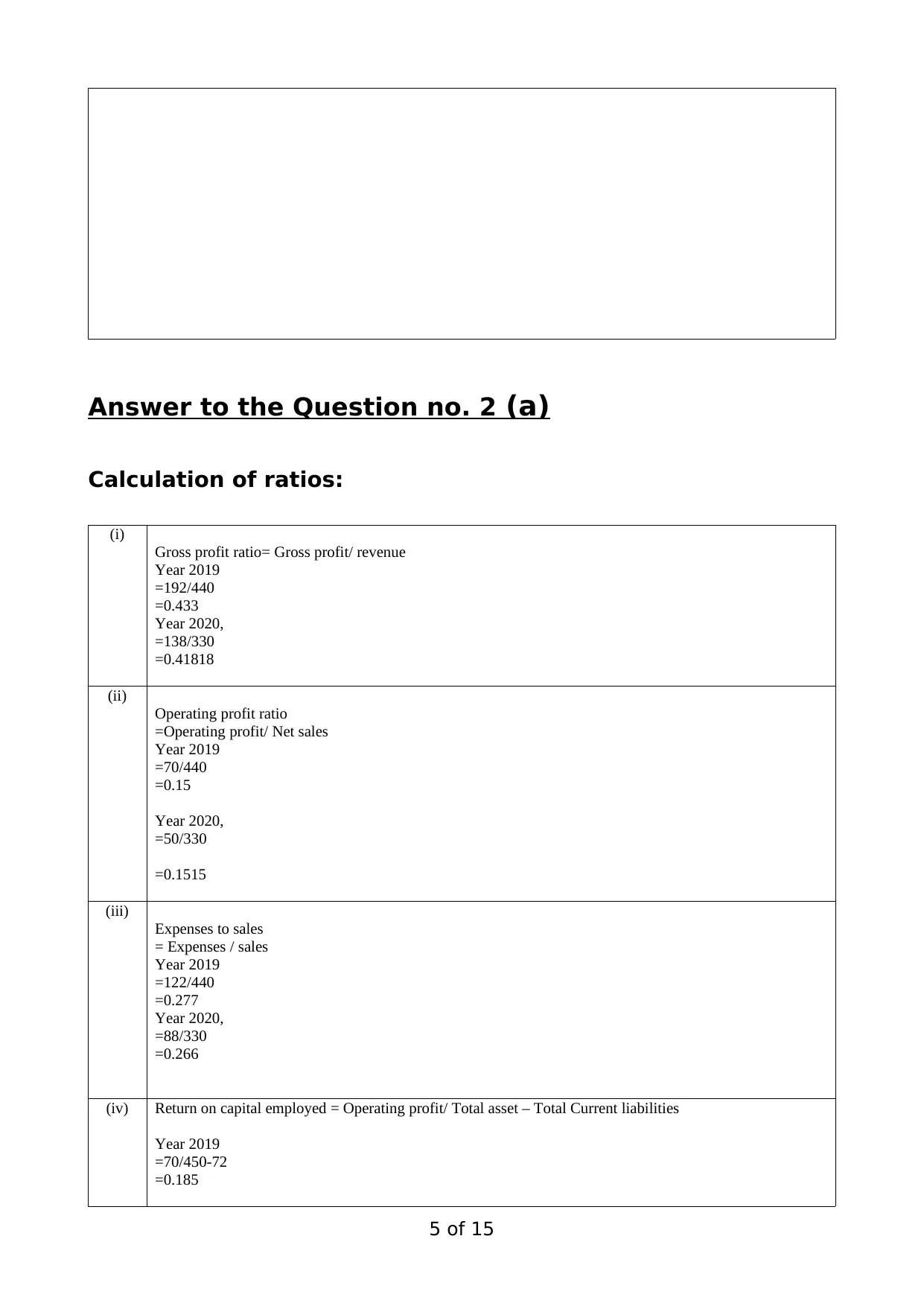
Answer to the Question no. 2 (a)
Calculation of ratios:
(i)
Gross profit ratio= Gross profit/ revenue
Year 2019
=192/440
=0.433
Year 2020,
=138/330
=0.41818
(ii)
Operating profit ratio
=Operating profit/ Net sales
Year 2019
=70/440
=0.15
Year 2020,
=50/330
=0.1515
(iii)
Expenses to sales
= Expenses / sales
Year 2019
=122/440
=0.277
Year 2020,
=88/330
=0.266
(iv) Return on capital employed = Operating profit/ Total asset – Total Current liabilities
Year 2019
=70/450-72
=0.185
5 of 15
Calculation of ratios:
(i)
Gross profit ratio= Gross profit/ revenue
Year 2019
=192/440
=0.433
Year 2020,
=138/330
=0.41818
(ii)
Operating profit ratio
=Operating profit/ Net sales
Year 2019
=70/440
=0.15
Year 2020,
=50/330
=0.1515
(iii)
Expenses to sales
= Expenses / sales
Year 2019
=122/440
=0.277
Year 2020,
=88/330
=0.266
(iv) Return on capital employed = Operating profit/ Total asset – Total Current liabilities
Year 2019
=70/450-72
=0.185
5 of 15
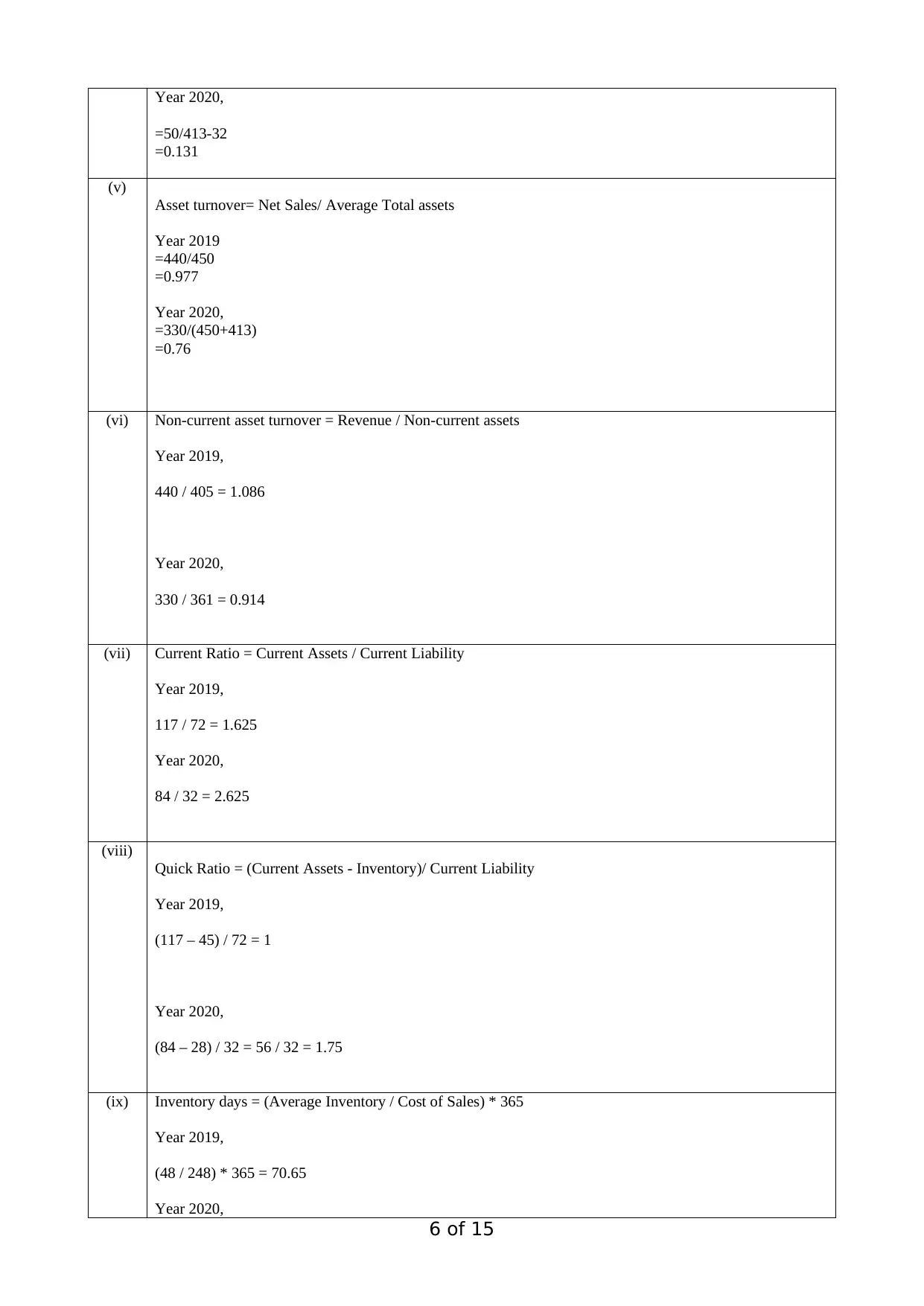
Year 2020,
=50/413-32
=0.131
(v)
Asset turnover= Net Sales/ Average Total assets
Year 2019
=440/450
=0.977
Year 2020,
=330/(450+413)
=0.76
(vi) Non-current asset turnover = Revenue / Non-current assets
Year 2019,
440 / 405 = 1.086
Year 2020,
330 / 361 = 0.914
(vii) Current Ratio = Current Assets / Current Liability
Year 2019,
117 / 72 = 1.625
Year 2020,
84 / 32 = 2.625
(viii)
Quick Ratio = (Current Assets - Inventory)/ Current Liability
Year 2019,
(117 – 45) / 72 = 1
Year 2020,
(84 – 28) / 32 = 56 / 32 = 1.75
(ix) Inventory days = (Average Inventory / Cost of Sales) * 365
Year 2019,
(48 / 248) * 365 = 70.65
Year 2020,
6 of 15
=50/413-32
=0.131
(v)
Asset turnover= Net Sales/ Average Total assets
Year 2019
=440/450
=0.977
Year 2020,
=330/(450+413)
=0.76
(vi) Non-current asset turnover = Revenue / Non-current assets
Year 2019,
440 / 405 = 1.086
Year 2020,
330 / 361 = 0.914
(vii) Current Ratio = Current Assets / Current Liability
Year 2019,
117 / 72 = 1.625
Year 2020,
84 / 32 = 2.625
(viii)
Quick Ratio = (Current Assets - Inventory)/ Current Liability
Year 2019,
(117 – 45) / 72 = 1
Year 2020,
(84 – 28) / 32 = 56 / 32 = 1.75
(ix) Inventory days = (Average Inventory / Cost of Sales) * 365
Year 2019,
(48 / 248) * 365 = 70.65
Year 2020,
6 of 15
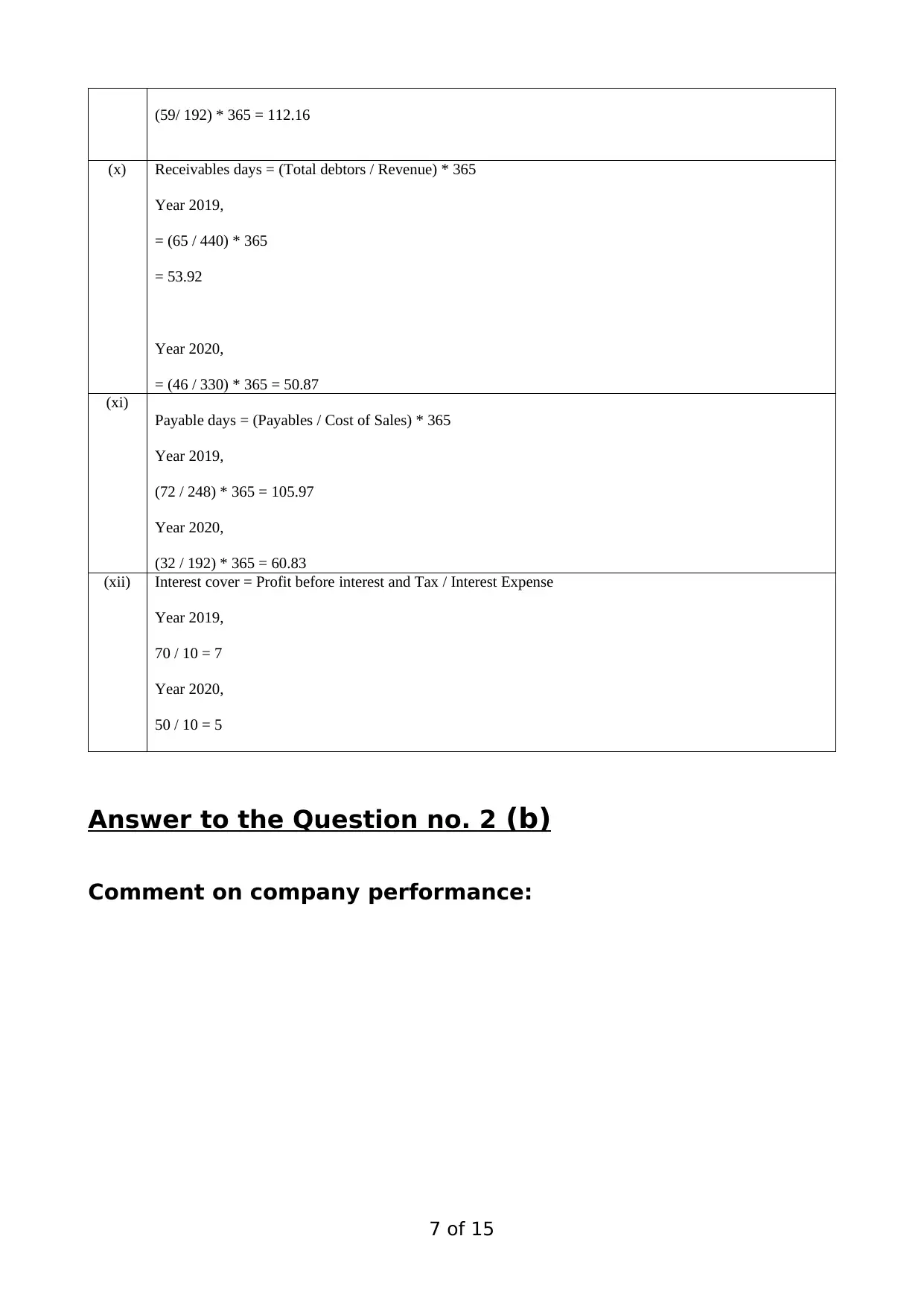
(59/ 192) * 365 = 112.16
(x) Receivables days = (Total debtors / Revenue) * 365
Year 2019,
= (65 / 440) * 365
= 53.92
Year 2020,
= (46 / 330) * 365 = 50.87
(xi)
Payable days = (Payables / Cost of Sales) * 365
Year 2019,
(72 / 248) * 365 = 105.97
Year 2020,
(32 / 192) * 365 = 60.83
(xii) Interest cover = Profit before interest and Tax / Interest Expense
Year 2019,
70 / 10 = 7
Year 2020,
50 / 10 = 5
Answer to the Question no. 2 (b)
Comment on company performance:
7 of 15
(x) Receivables days = (Total debtors / Revenue) * 365
Year 2019,
= (65 / 440) * 365
= 53.92
Year 2020,
= (46 / 330) * 365 = 50.87
(xi)
Payable days = (Payables / Cost of Sales) * 365
Year 2019,
(72 / 248) * 365 = 105.97
Year 2020,
(32 / 192) * 365 = 60.83
(xii) Interest cover = Profit before interest and Tax / Interest Expense
Year 2019,
70 / 10 = 7
Year 2020,
50 / 10 = 5
Answer to the Question no. 2 (b)
Comment on company performance:
7 of 15
Paraphrase This Document
Need a fresh take? Get an instant paraphrase of this document with our AI Paraphraser
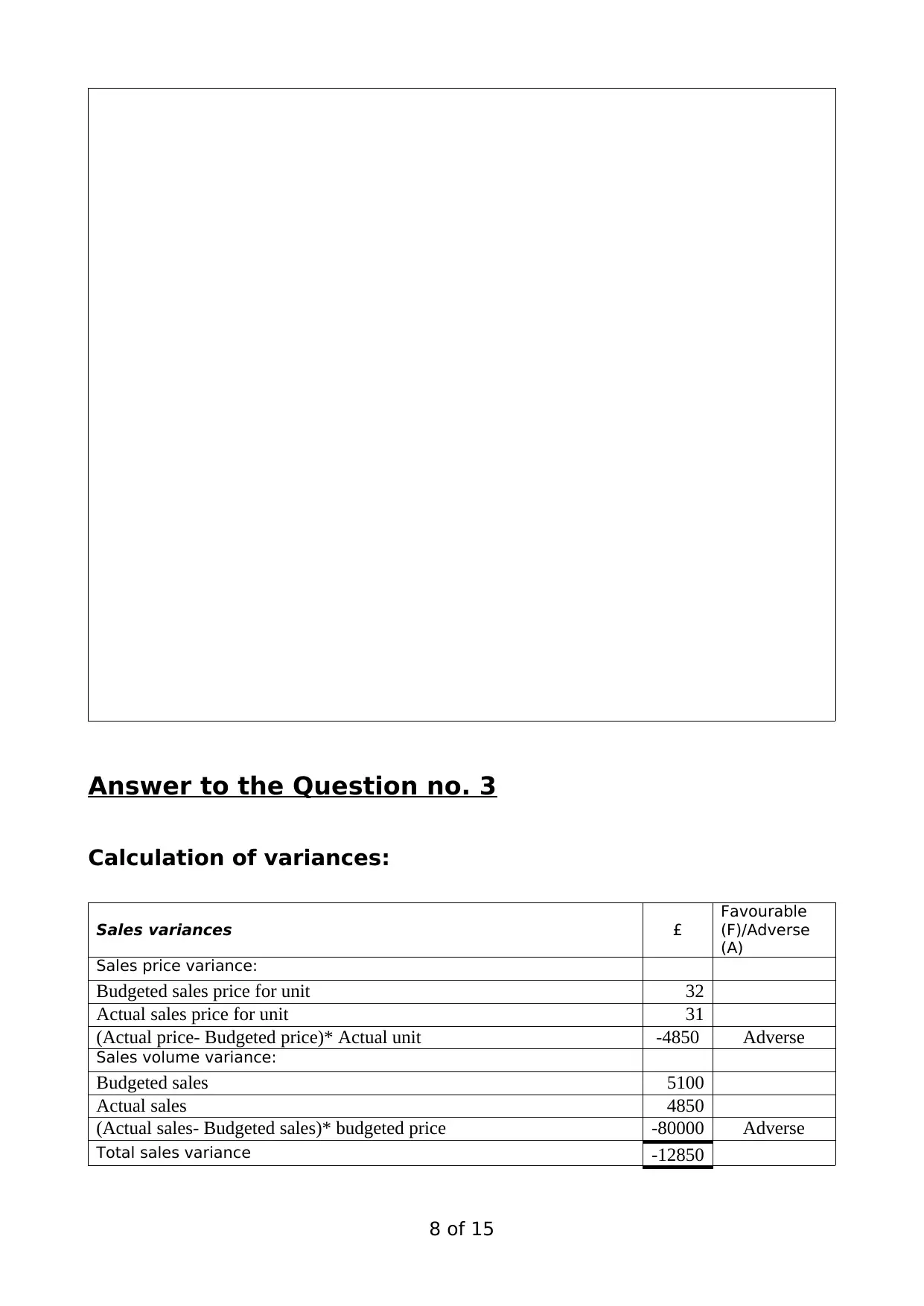
Answer to the Question no. 3
Calculation of variances:
Sales variances £
Favourable
(F)/Adverse
(A)
Sales price variance:
Budgeted sales price for unit 32
Actual sales price for unit 31
(Actual price- Budgeted price)* Actual unit -4850 Adverse
Sales volume variance:
Budgeted sales 5100
Actual sales 4850
(Actual sales- Budgeted sales)* budgeted price -80000 Adverse
Total sales variance -12850
8 of 15
Calculation of variances:
Sales variances £
Favourable
(F)/Adverse
(A)
Sales price variance:
Budgeted sales price for unit 32
Actual sales price for unit 31
(Actual price- Budgeted price)* Actual unit -4850 Adverse
Sales volume variance:
Budgeted sales 5100
Actual sales 4850
(Actual sales- Budgeted sales)* budgeted price -80000 Adverse
Total sales variance -12850
8 of 15
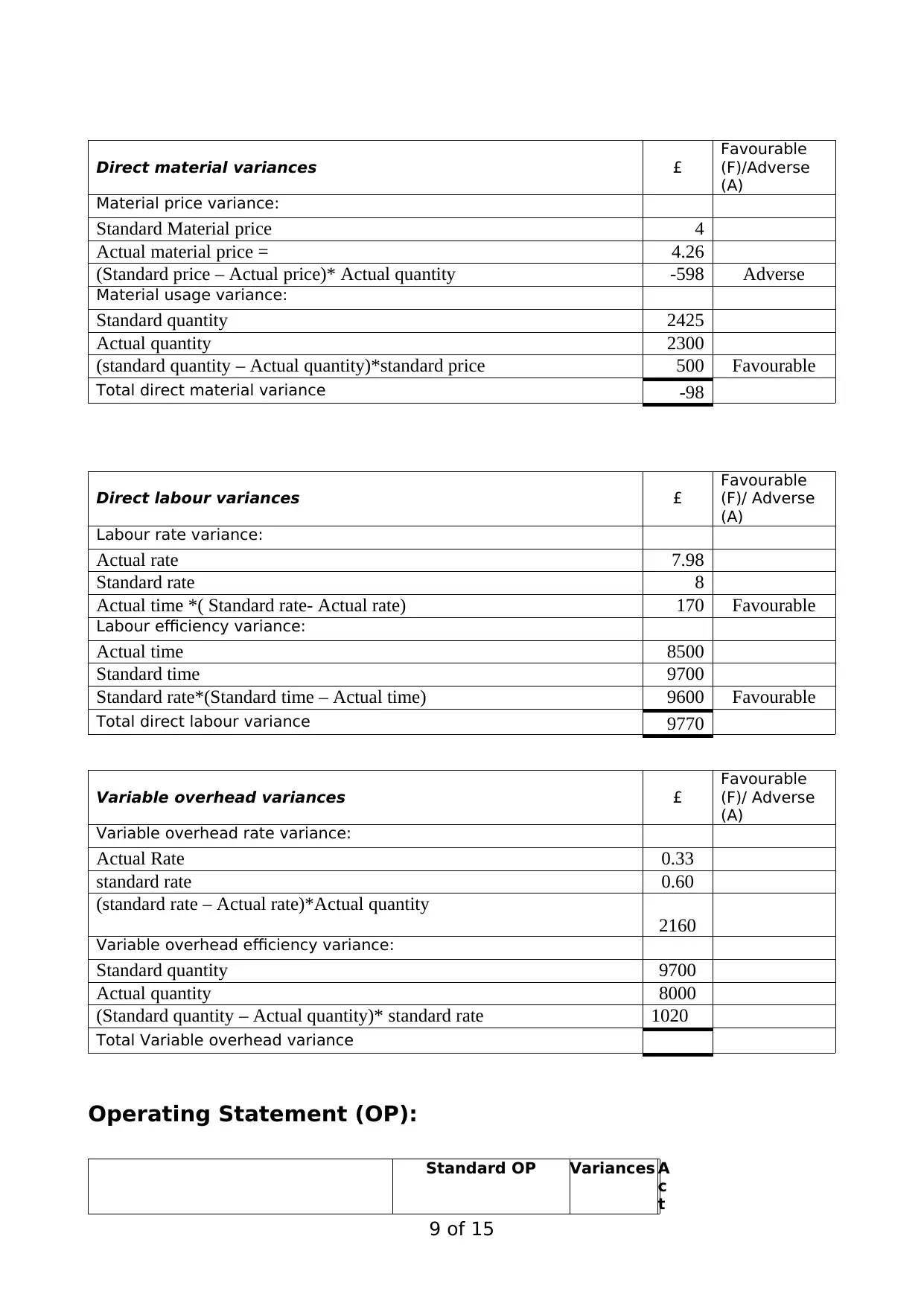
Direct material variances £
Favourable
(F)/Adverse
(A)
Material price variance:
Standard Material price 4
Actual material price = 4.26
(Standard price – Actual price)* Actual quantity -598 Adverse
Material usage variance:
Standard quantity 2425
Actual quantity 2300
(standard quantity – Actual quantity)*standard price 500 Favourable
Total direct material variance -98
Direct labour variances £
Favourable
(F)/ Adverse
(A)
Labour rate variance:
Actual rate 7.98
Standard rate 8
Actual time *( Standard rate- Actual rate) 170 Favourable
Labour efficiency variance:
Actual time 8500
Standard time 9700
Standard rate*(Standard time – Actual time) 9600 Favourable
Total direct labour variance 9770
Variable overhead variances £
Favourable
(F)/ Adverse
(A)
Variable overhead rate variance:
Actual Rate 0.33
standard rate 0.60
(standard rate – Actual rate)*Actual quantity
2160
Variable overhead efficiency variance:
Standard quantity 9700
Actual quantity 8000
(Standard quantity – Actual quantity)* standard rate 1020
Total Variable overhead variance
Operating Statement (OP):
Standard OP Variances A
c
t
9 of 15
Favourable
(F)/Adverse
(A)
Material price variance:
Standard Material price 4
Actual material price = 4.26
(Standard price – Actual price)* Actual quantity -598 Adverse
Material usage variance:
Standard quantity 2425
Actual quantity 2300
(standard quantity – Actual quantity)*standard price 500 Favourable
Total direct material variance -98
Direct labour variances £
Favourable
(F)/ Adverse
(A)
Labour rate variance:
Actual rate 7.98
Standard rate 8
Actual time *( Standard rate- Actual rate) 170 Favourable
Labour efficiency variance:
Actual time 8500
Standard time 9700
Standard rate*(Standard time – Actual time) 9600 Favourable
Total direct labour variance 9770
Variable overhead variances £
Favourable
(F)/ Adverse
(A)
Variable overhead rate variance:
Actual Rate 0.33
standard rate 0.60
(standard rate – Actual rate)*Actual quantity
2160
Variable overhead efficiency variance:
Standard quantity 9700
Actual quantity 8000
(Standard quantity – Actual quantity)* standard rate 1020
Total Variable overhead variance
Operating Statement (OP):
Standard OP Variances A
c
t
9 of 15
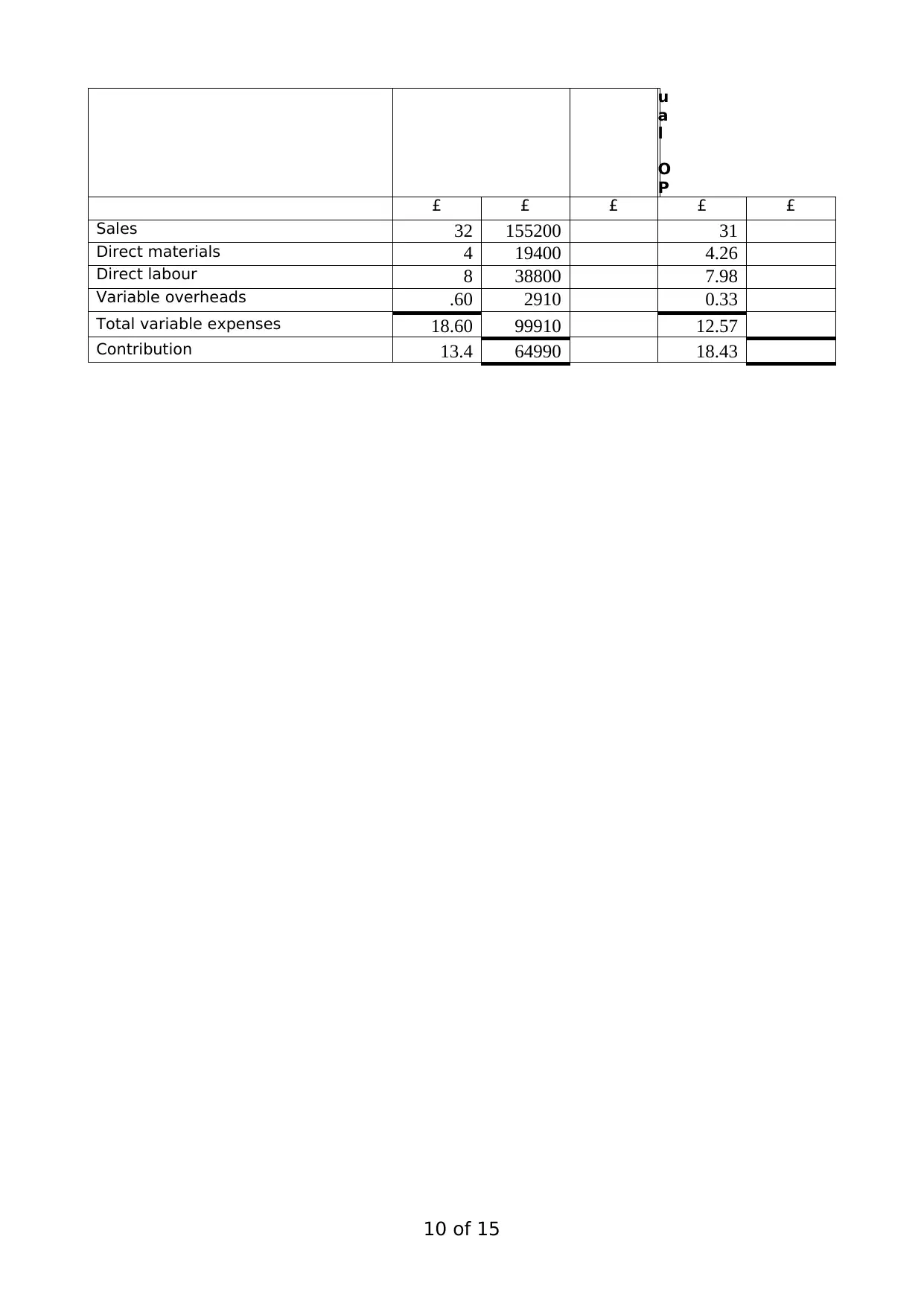
u
a
l
O
P
£ £ £ £ £
Sales 32 155200 31
Direct materials 4 19400 4.26
Direct labour 8 38800 7.98
Variable overheads .60 2910 0.33
Total variable expenses 18.60 99910 12.57
Contribution 13.4 64990 18.43
10 of 15
a
l
O
P
£ £ £ £ £
Sales 32 155200 31
Direct materials 4 19400 4.26
Direct labour 8 38800 7.98
Variable overheads .60 2910 0.33
Total variable expenses 18.60 99910 12.57
Contribution 13.4 64990 18.43
10 of 15
Secure Best Marks with AI Grader
Need help grading? Try our AI Grader for instant feedback on your assignments.
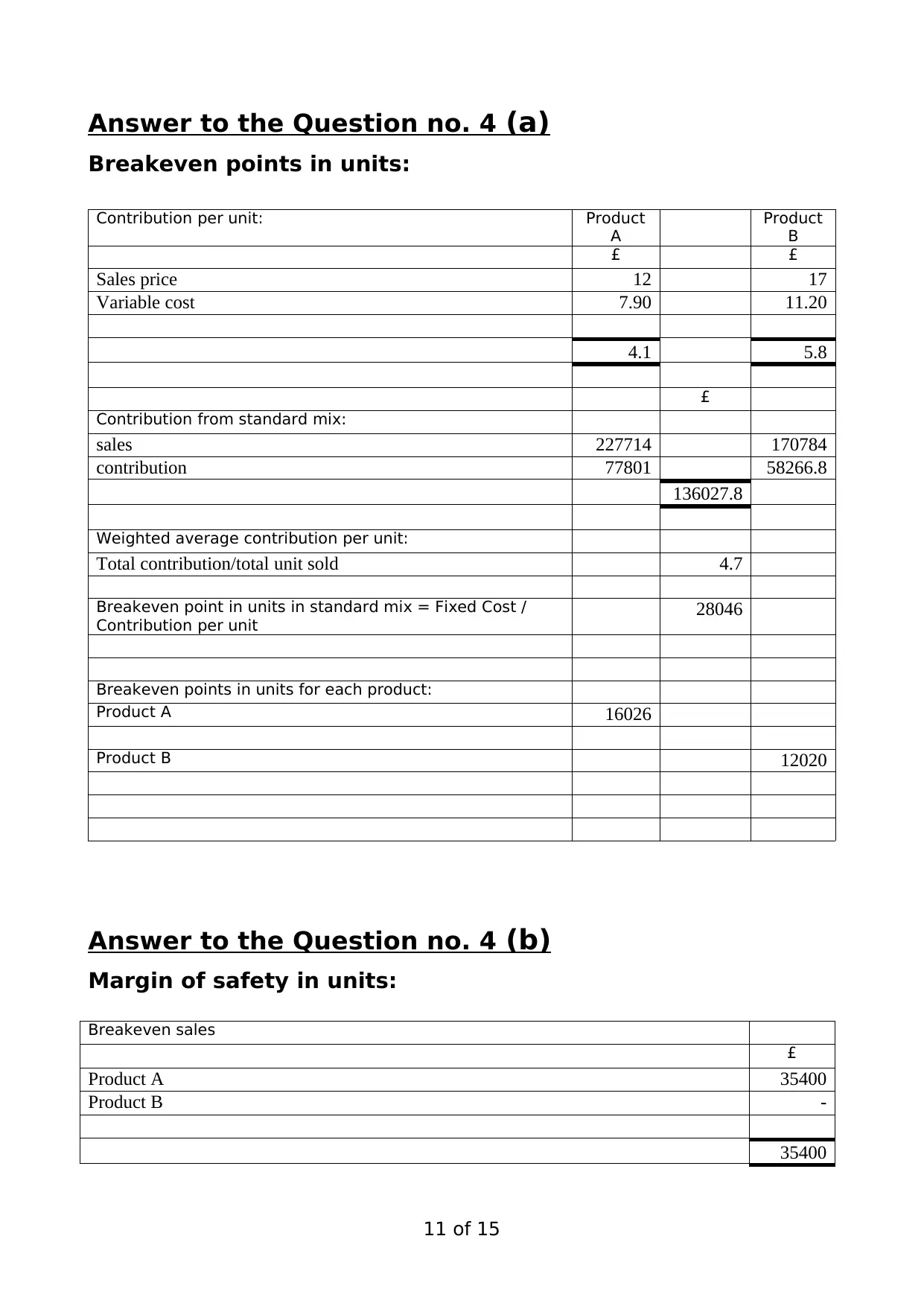
Answer to the Question no. 4 (a)
Breakeven points in units:
Contribution per unit: Product
A
Product
B
£ £
Sales price 12 17
Variable cost 7.90 11.20
4.1 5.8
£
Contribution from standard mix:
sales 227714 170784
contribution 77801 58266.8
136027.8
Weighted average contribution per unit:
Total contribution/total unit sold 4.7
Breakeven point in units in standard mix = Fixed Cost /
Contribution per unit 28046
Breakeven points in units for each product:
Product A 16026
Product B 12020
Answer to the Question no. 4 (b)
Margin of safety in units:
Breakeven sales
£
Product A 35400
Product B -
35400
11 of 15
Breakeven points in units:
Contribution per unit: Product
A
Product
B
£ £
Sales price 12 17
Variable cost 7.90 11.20
4.1 5.8
£
Contribution from standard mix:
sales 227714 170784
contribution 77801 58266.8
136027.8
Weighted average contribution per unit:
Total contribution/total unit sold 4.7
Breakeven point in units in standard mix = Fixed Cost /
Contribution per unit 28046
Breakeven points in units for each product:
Product A 16026
Product B 12020
Answer to the Question no. 4 (b)
Margin of safety in units:
Breakeven sales
£
Product A 35400
Product B -
35400
11 of 15
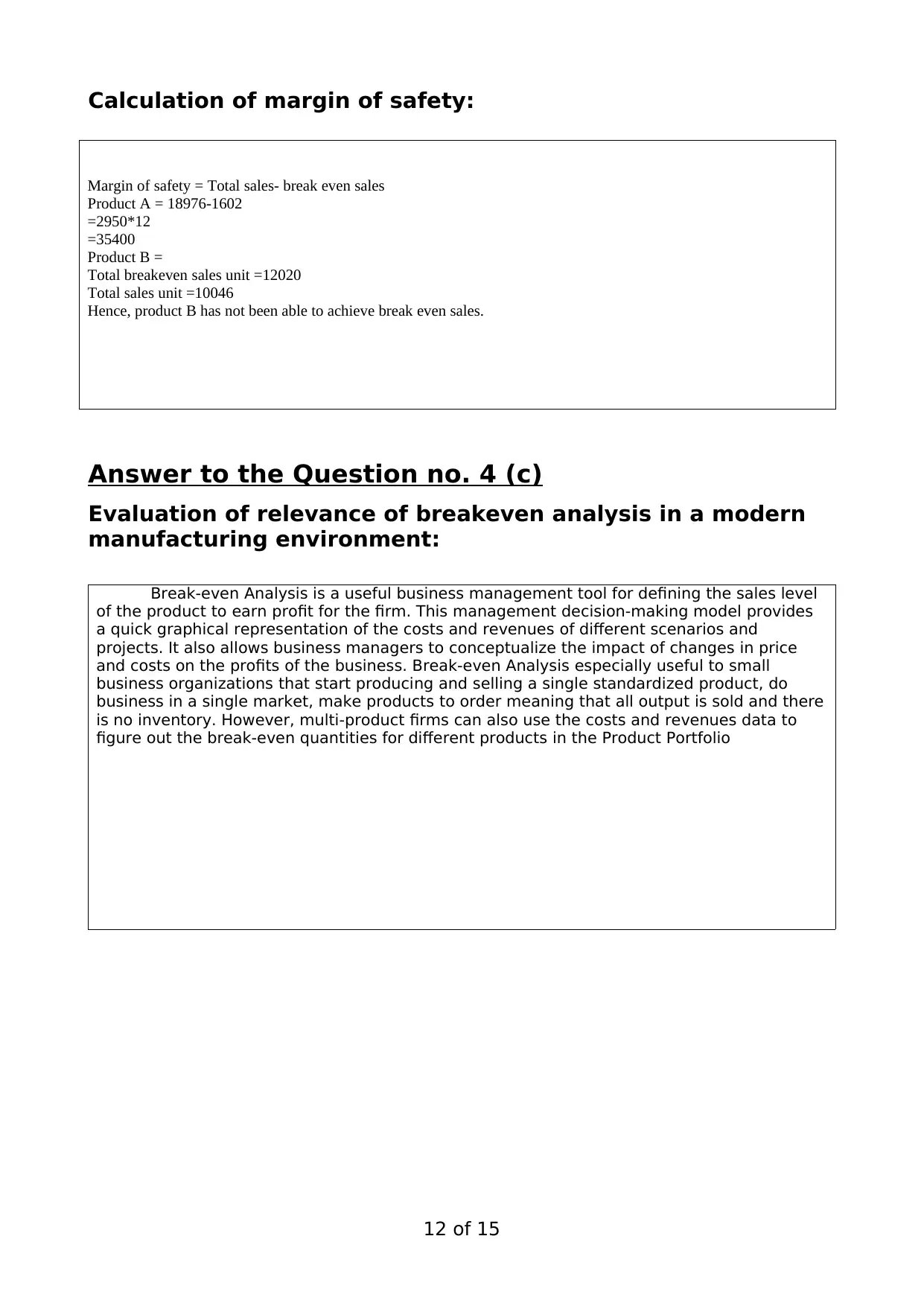
Calculation of margin of safety:
Margin of safety = Total sales- break even sales
Product A = 18976-1602
=2950*12
=35400
Product B =
Total breakeven sales unit =12020
Total sales unit =10046
Hence, product B has not been able to achieve break even sales.
Answer to the Question no. 4 (c)
Evaluation of relevance of breakeven analysis in a modern
manufacturing environment:
Break-even Analysis is a useful business management tool for defining the sales level
of the product to earn profit for the firm. This management decision-making model provides
a quick graphical representation of the costs and revenues of different scenarios and
projects. It also allows business managers to conceptualize the impact of changes in price
and costs on the profits of the business. Break-even Analysis especially useful to small
business organizations that start producing and selling a single standardized product, do
business in a single market, make products to order meaning that all output is sold and there
is no inventory. However, multi-product firms can also use the costs and revenues data to
figure out the break-even quantities for different products in the Product Portfolio
12 of 15
Margin of safety = Total sales- break even sales
Product A = 18976-1602
=2950*12
=35400
Product B =
Total breakeven sales unit =12020
Total sales unit =10046
Hence, product B has not been able to achieve break even sales.
Answer to the Question no. 4 (c)
Evaluation of relevance of breakeven analysis in a modern
manufacturing environment:
Break-even Analysis is a useful business management tool for defining the sales level
of the product to earn profit for the firm. This management decision-making model provides
a quick graphical representation of the costs and revenues of different scenarios and
projects. It also allows business managers to conceptualize the impact of changes in price
and costs on the profits of the business. Break-even Analysis especially useful to small
business organizations that start producing and selling a single standardized product, do
business in a single market, make products to order meaning that all output is sold and there
is no inventory. However, multi-product firms can also use the costs and revenues data to
figure out the break-even quantities for different products in the Product Portfolio
12 of 15

Answer to the Question no. 5
Significant steps in setting a financial/cost controlling
budget in a large organisation.
13 of 15
Significant steps in setting a financial/cost controlling
budget in a large organisation.
13 of 15
Paraphrase This Document
Need a fresh take? Get an instant paraphrase of this document with our AI Paraphraser
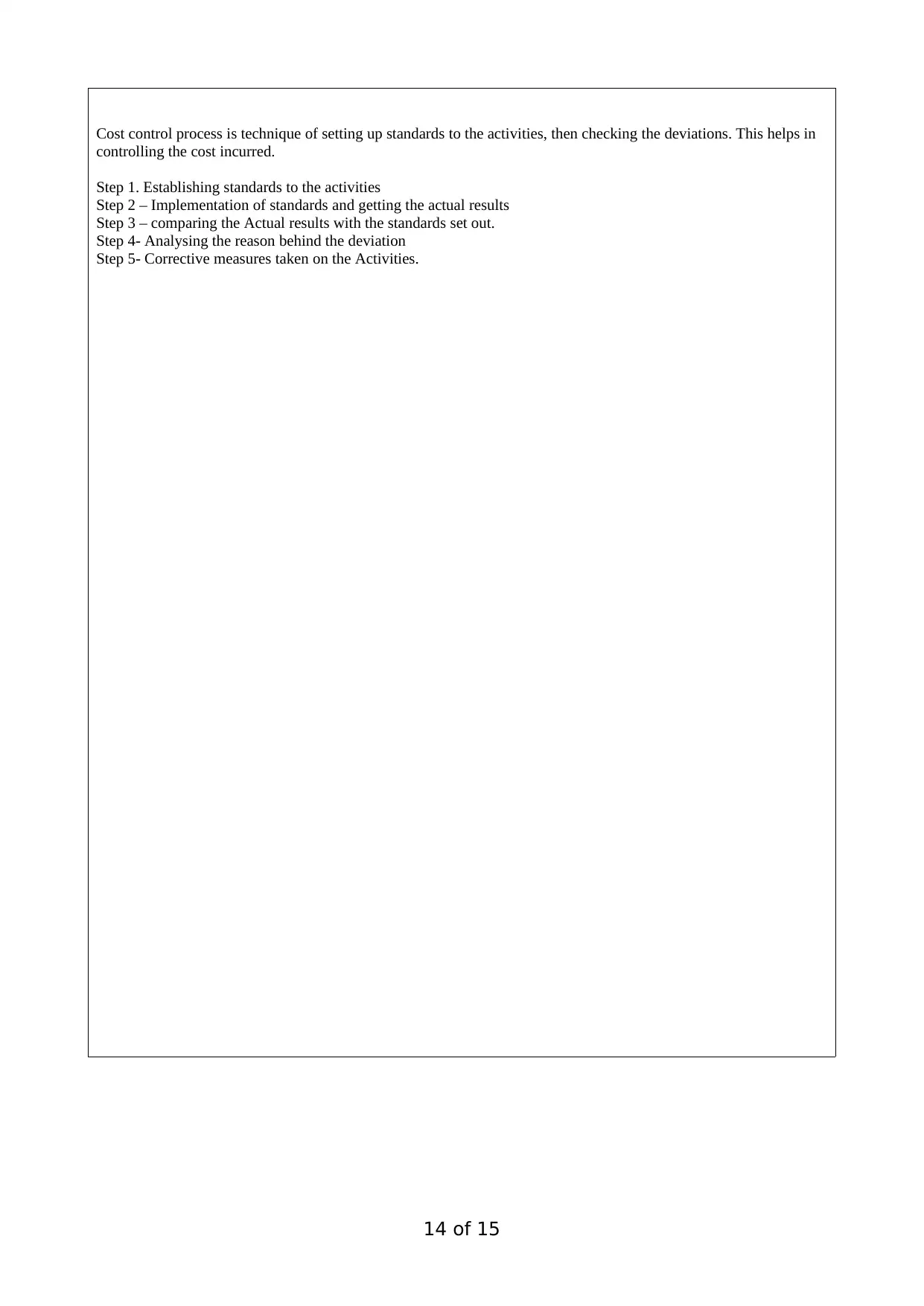
Cost control process is technique of setting up standards to the activities, then checking the deviations. This helps in
controlling the cost incurred.
Step 1. Establishing standards to the activities
Step 2 – Implementation of standards and getting the actual results
Step 3 – comparing the Actual results with the standards set out.
Step 4- Analysing the reason behind the deviation
Step 5- Corrective measures taken on the Activities.
14 of 15
controlling the cost incurred.
Step 1. Establishing standards to the activities
Step 2 – Implementation of standards and getting the actual results
Step 3 – comparing the Actual results with the standards set out.
Step 4- Analysing the reason behind the deviation
Step 5- Corrective measures taken on the Activities.
14 of 15

15 of 15
1 out of 15
Related Documents
Your All-in-One AI-Powered Toolkit for Academic Success.
+13062052269
info@desklib.com
Available 24*7 on WhatsApp / Email
![[object Object]](/_next/static/media/star-bottom.7253800d.svg)
Unlock your academic potential
© 2024 | Zucol Services PVT LTD | All rights reserved.




